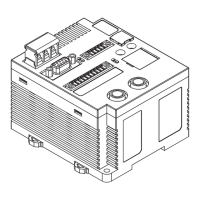4-5SectionOperation Test (TEST)
67
2. Specify the end address. When either of the horizontal cursor keys is
pressed, the display changes to the end address.
Note a) Ensure
that the start address does not exceed
the end address.
b) In
the case of a DC with SRAM, page 0 addresses 00 and 01 are
reserved
for registration of the production date (year
, month, day),
and
data
cannot be written in this area. Note also when using this
function that addresses 02 to 05 are write protected (see page
22).
3. Specify
the data to be written. The example below shows the procedure for
writing 0F to all 16 addresses 50 to 5F.
DC
Set
the page number
in the job specification.
00
to
50
to
5F
to
FF
“OF”
00001111
00001111
4. When
the WRITE2 Key is pressed, “C–WRITE?” is shown
at the left end of
the display.
5. When
the
SET Key is pressed, the same data is written to all the specified
DC addresses.
Note If
no R/W Head is connected, if the DC is not in the communications
range,
or if a communication error occurs, an error code is displayed
(see page
97). When this happens, use the horizontal cursor keys to
display the error message.
4-5 Operation
T
est (TEST)
When
checking the installation of the R/W Heads and the DC, TEST can be used
to initiate communications to establish the type of installation relationship and
the
relative speeds. T
est
commands are available for read, write, auto read, and
auto write operations.
The
job specification head and page numbers are objects of the test commands.
If
the job specification has already been made, check the respective settings. If
the job specification has not been made, the test commands use Head 1 and
Page
0. Note
that if the start and end addresses have been set, the entire area
they define is used by the test commands.
Preparations for Executing
Test Commands

